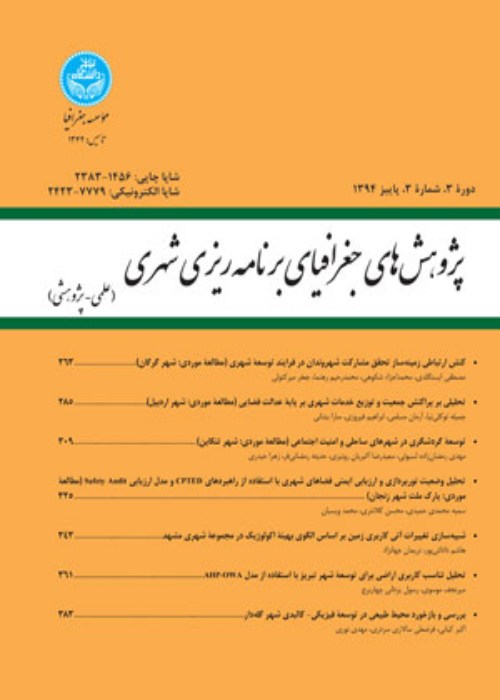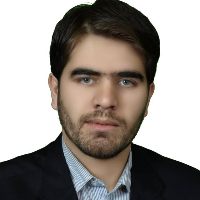Spatial evaluation of the quality of urban life The case study of the district 2 of Tehran
Evaluation and quantification of the quality of urban life is one of the important and key prerequisites in urban planning and development. The purpose of this study is to provide a strategy based on a multi-criteria decision-making system to evaluate the quality of urban life. For this purpose, 8 environmental criteria and 6 infrastructure criteria were used. The weight of the effective criteria was calculated based on the opinion of experts using the BWM. Then, the OWA method was exerted to produce urban life quality maps in different mental scenarios. Finally, the spatial distribution of the population in different classes of quality of urban life was evaluated. Among the infrastructural and environmental criteria, population density and air pollution had the most significant impact on the quality of urban life. The quality of urban life maps in different scenarios showed that with the increase in the degree of optimism, the area of the classes with high and very high quality of urban life increases, and with the decrease of the degree of optimism, the area of the classes with high and very high quality of urban life decreases. The results of this study showed that a high percentage of the population in the urban environment lives in conditions of low quality of urban life, which indicates the necessity of evaluating the current state of the quality of urban life and planning to improve the existing state.
The growth of cities since the beginning of the 20th century, the exponential increase of the urban population, the inappropriate and disorganized physical growth, and the quantitative approach to urban planning and neighborhoods have changed the culture of neighborhoods, inter-neighborhood migrations, and dissatisfaction with the quality of urban environments, which has been accompanied by the loss of identity and sense of belonging among residents. Therefore, to deal with such a trend, an approach called the quality of urban life has been proposed to create a desirable urban life. This approach is based on the belief that urban places, as part of human identity, also form an emotional bond between people and their surroundings. Therefore, paying attention to the quality of urban life can create a sense of belonging and identity in citizens towards the urban environment. Thus, this study aims to evaluate the quality of urban life in District 2 of Tehran by insisting on risk in decision-making. To achieve this goal, a risk-based expert system based on a geographic information system will be used. This system's ability is flexible in creating a wide range of scenarios (very optimistic to very pessimistic).
The spatial data in this study includes satellite-based data, location-based field data, and spatial layers collected from related organizations. The research method in this study includes five steps. In the first stage, using past studies and experts' opinions, effective criteria for the quality of urban life were identified, and a spatial database of these data was created. In the second stage, due to the different sources of the collected data, the pre-processing operation was done on the data first. Then, according to the type of criterion, a map of the criteria was prepared using spatial analysis in GIS. Normalization of the criteria map, calculation of weight, and importance of criteria and sequential weights were done in the third stage. In the fourth step, using the ordered weighted averaging method, quality of urban life maps was prepared in different decision-making scenarios for environmental and infrastructure dimensions. Also, at this stage, the final quality of urban life maps was prepared by combining the two considered dimensions. Finally, in the fifth stage, an assessment of population distribution in urban quality of life classes was done.
In this study, in the environmental dimension, air pollution, discomfort index, and vegetation cover criteria had the highest weight, and elevation, distance from stream network, and distance from fault had the lowest weight. Also, in terms of infrastructure, population density and distance from the road network have the most weight, and the criteria of distance from industrial areas and medical centers have the least weight. The visual evaluation of the quality of urban life maps in the environmental dimension shows that the eastern and central half of the studied area has a better quality of urban life than other regions. This is due to the adjustment of the urban microclimate in accordance with the increase of vegetation, reduction of air pollution, and improvement of the condition of discomfort index towards the eastern and central parts, directly affecting other environmental indicators. Regarding infrastructural criteria, the areas located north of the study area have the worst quality of urban life, and most areas with very low quality of urban life are located in these areas. However, the central parts of the studied region have a more favorable quality of urban life than other parts. The road network infrastructure, subway stations, medical centers, and parks are more concentrated in these areas than in others.
The combination of urban life quality maps in environmental and infrastructure dimensions showed that with the increase in the degree of optimism, the area of the areas located in the high and very high quality of urban life class increases, and the area of the areas located in the low and very low quality of urban life class decreases. So, the very low, low, medium, high, and very high quality of urban life in the very pessimistic scenario was 11.84, 20.07, 11.17, 3.73, and 1.58 km2, respectively. In a very optimistic scenario, these values would reach 3.46, 6.42, 13.79, 15.78, and 8.96 km2.
From an environmental point of view, air pollution and distance from the fault criteria, respectively, have the most and the least impact on modeling the quality of urban life. Also, in terms of infrastructure, the population density criterion has the most impact, and the distance from industrial areas criterion has the least impact in modeling the quality of urban life. The central and eastern regions of the studied region have better urban life quality conditions than other regions. With the increase in the degree of optimism, the area of the areas located in the class of high and very high quality of urban life increases, and the area of the areas located in the class of low and very low quality of urban life decreases. In the very pessimistic, pessimistic, intermediate, optimistic, and very optimistic scenarios, respectively, 5.31, 7.94, 10.24, 14.66, and 24.73 square kilometers of the studied area have suitable urban life quality conditions (high and very high class). In a very pessimistic state, 650,963 and 9,162 thousand people of the study area population are located in areas with unsuitable (low and very low class) and suitable (high and very high) quality of urban life, respectively. The results of this study can be useful for managers and planners to implement plans and programs to improve the quality of urban life.
- حق عضویت دریافتی صرف حمایت از نشریات عضو و نگهداری، تکمیل و توسعه مگیران میشود.
- پرداخت حق اشتراک و دانلود مقالات اجازه بازنشر آن در سایر رسانههای چاپی و دیجیتال را به کاربر نمیدهد.



